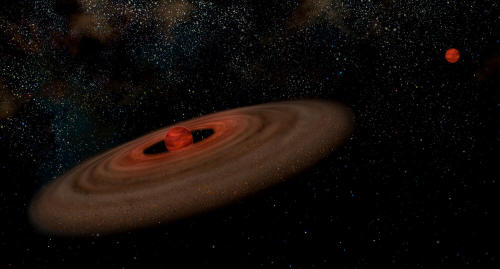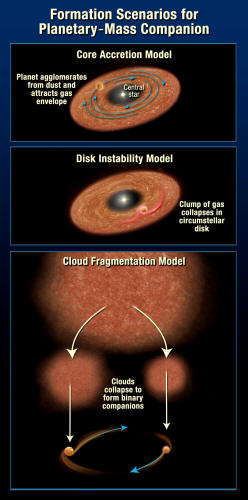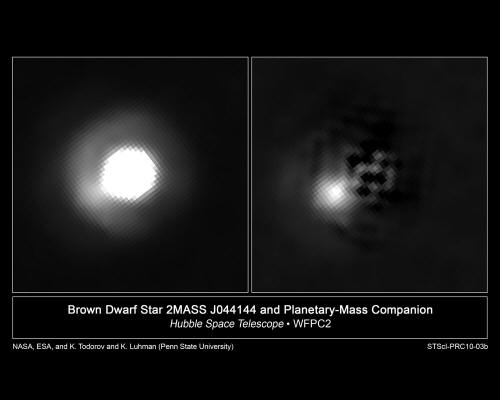|
by Ray Villard and Barbara
Kennedy from PennStateScience-EberlyCollegeOfScience Website
showing the primary brown dwarf (at left) and its orbiting planet-like object (at right). The disk of the brown dwarf likely never had enough material to make an orbiting object of this mass. As a result, this small companion probably formed like a binary star. In this illustration, both objects are presented at the same distance to show relative sizes.
Not shown are two
other nearby objects, a low-mass star and a brown dwarf that are
probably both parts of this system. A mysterious planet-like object orbiting a not-quite-starlike "brown dwarf" is the most recent enigma discovered by astronomers with their ever-more powerful telescopes.
Kamen Todorov, a graduate student at Penn State University, and a team of co-investigators including Kevin Luhman, assistant professor of astronomy and astrophysics at Penn State, used the keen eyesight of the Hubble Space Telescope and the Gemini observatory to directly image the planet-like object.
The team's discovery, which resulted
from a survey of 32 brown dwarfs in the Taurus star-forming region,
will be published in the
Astrophysical Journal.
Their investigations of the nature of this mysterious object and its companion brown dwarf have revealed a new mechanism that Nature can use to make orbiting planetary-mass objects.
It has a companion object at the 8 o'clock position that is estimated to be 5-10 times the mass of Jupiter. In the right panel, the light from the brown dwarf has been subtracted to provide a clearer view of the companion object. The separation of the companion corresponds to 1.4 billion miles at the distance of the Taurus star-forming region, which is only about 1 million years old. The companion may be a very small brown dwarf or a large planet, depending on how it formed. Images were taken with Hubble's Wide Field Planetary Camera 2 to track the motion of the two objects to see if they actually do travel across space together.
Additional
observations were done with the Gemini North telescope on Mauna Kea,
Hawaii.
To answer this question, the scientists considered the three possible ways such an object could form:
Although the second mechanism does occur rapidly, the disk around this central brown dwarf probably did not contain enough material to make an object this large in mass.
If the mystery companion formed through cloud collapse and fragmentation, as stellar binary systems do, then it is not a planet by definition because planets build up inside disks.
Further supporting evidence comes from the presence of a nearby binary system that contains a small red star and a brown dwarf. Brown dwarfs are objects that typically are tens of times the mass of Jupiter and are too small to sustain nuclear fusion to shine as stars do.
Luhman thinks that all four objects may have formed in the same cloud collapse, making this in actuality a quadruple system.
|



